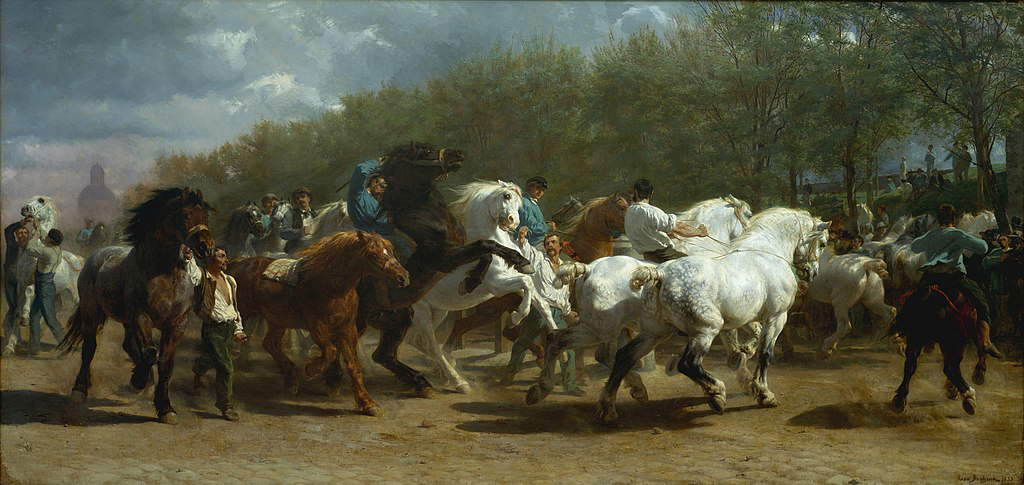Supercult. Linda Nochlin on Rosa Bonheur
While rejecting in complete good faith the conventional feminine role of the time, Rosa Bonheur ran into what Betty Friedan calls “the lace blouse syndrome”: that innocuous version of feminine protest that still prompts successful women, such as psychiatrists or professors, to dress ultra-femininely or bake cakes all the time. Although from a young age she wore her hair short and wore men’s clothes, following the example of George Sand, whose rustic romanticism exerted a strong influence on her artistic imagination, she insisted with conviction that this was only due to specific professional needs. Indignantly debunking the rumor that as a young girl she scandalized Paris by walking around dressed as a boy, she proudly handed over to her biographer a daguerreotype depicting her as a sixteen-year-old, perfectly attired according to the feminine fashion in vogue; the only exception being her very short hair, which she justified as a practical expedient adopted after the death of her mother: “Who would take care of my curls?”
Regarding men’s clothes, she promptly rejected her interlocutor’s idea that pants were a symbol of clear emancipation: “I solemnly blame women who give up normal clothes in the desire to pass for men,” she said, thus implicitly rejecting George Sand as a prototype.

“If I thought that pants were suitable for my sex I would have disposed of skirts, but I did not; nor did I ever advise my sisters to wear men’s clothes in daily life. So, if you see me dressed like this, it is not to make me stand out, as many other women try to do, but only to facilitate my work. Don’t forget that for a time I spent entire days in slaughterhouses. One has to really love one’s art to live amidst pools of blood [...] Horses also fascinate me, and what better place to study these animals than at the fairgrounds, amidst the excrement? I could not help but realize that women’s clothes were a real nuisance. This is why I decided to ask the prefect of police for permission to use men’s clothes. But what I am wearing is nothing more than my work outfit. The remarks of fools have never troubled me. Even Nathalie [his partner] laughs about it. Seeing me dressed as a man does not upset her at all, but if it gives you the slightest thought, I would have no difficulty putting on a skirt, since I have a full assortment of women’s clothes in my closet.”
At the same time, however, she admits, “Pants have been my salvation [...] Many times I have congratulated myself for having the courage to break with a tradition that would have prevented me from certain jobs, having to drag my skirts everywhere.” Nevertheless, the famous artist still feels compelled to justify her sincere admission with a misunderstood “femininity”: “In spite of my changes in dress, there is no daughter of Eve who appreciates frivolities more than I do; my brusque and unsociable disposition has never prevented my heart from remaining completely feminine.”
It is quite pathetic that an artist of clear renown, tireless in the painstaking study of animal anatomy, a tenacious seeker of her subjects, oxen or horses, in the most unpleasant places, a prolific author of wildly popular works over a long career, endowed with a decisive, confident and undeniably masculine style, winner of the first prize at the Paris Salon, awarded the Legion d’honor, of the Order of Isabella the Catholic and the Order of Leopold, as well as a friend of Queen Victoria, should have felt for who knows what reason obliged at an advanced age to justify and explain her masculine ways while at the same time attacking her more modest colleagues in pants to silence her guilt. Despite paternal encouragement, nonconformity and the gratification of worldwide successes, her conscience still blamed her for not being “feminine” because she too was shaped by unconsciously internalized social norms and refracted to a rational examination of reality.
Even today, the difficulties imposed on an artist by such unconscious demands continue to add to an already daunting task. Celebrated contemporary sculptor Louise Nevelson combines an “anti-feminine” total dedication to her work with “very feminine” false eyelashes and openly admits that she took a husband at the age of seventeen, while certain that she could not give up her work, only because “everything suggested to me that I should marry.” Even for these two exceptional artists--whether we like The Equine Fair or not, we can only admire Rosa Bonheur’s achievements--the mystique of femininity, with its internalized ambiguities of narcissism and guilt, weakens and destroys with subtle work that full self-esteem, that absolute certainty, that moral and aesthetic security, necessary in art to the greatest and most innovative works.
---
Linda Nochlin, Why haven’t there been great women artists? (transl. it. Jessica Perna), Castelvecchi, Rome, 2014 [first published in original language: Art News, 1971], pp. 46-47
 |
| Supercult. Linda Nochlin on Rosa Bonheur |
Warning: the translation into English of the original Italian article was created using automatic tools. We undertake to review all articles, but we do not guarantee the total absence of inaccuracies in the translation due to the program. You can find the original by clicking on the ITA button. If you find any mistake,please contact us.





























